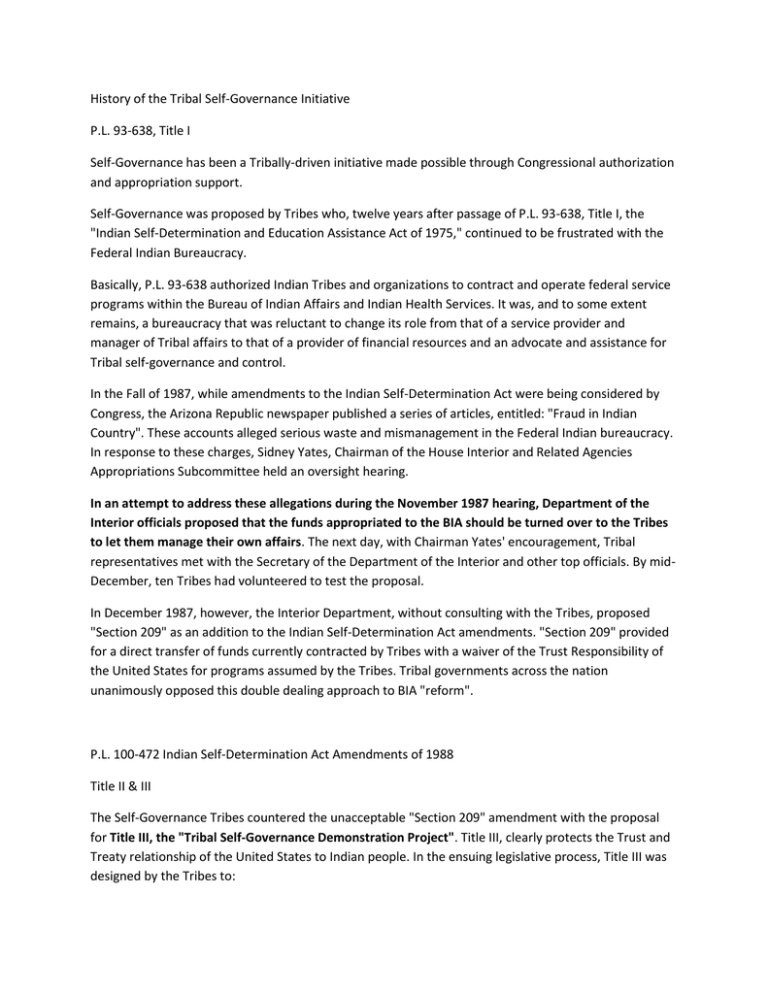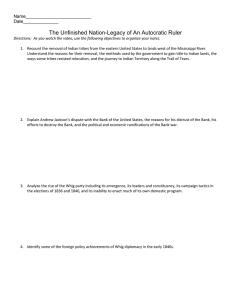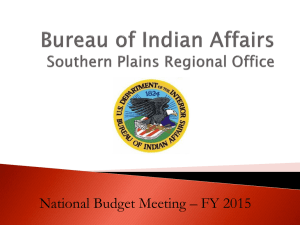History of Tribal Self Government
advertisement

History of the Tribal Self-Governance Initiative P.L. 93-638, Title I Self-Governance has been a Tribally-driven initiative made possible through Congressional authorization and appropriation support. Self-Governance was proposed by Tribes who, twelve years after passage of P.L. 93-638, Title I, the "Indian Self-Determination and Education Assistance Act of 1975," continued to be frustrated with the Federal Indian Bureaucracy. Basically, P.L. 93-638 authorized Indian Tribes and organizations to contract and operate federal service programs within the Bureau of Indian Affairs and Indian Health Services. It was, and to some extent remains, a bureaucracy that was reluctant to change its role from that of a service provider and manager of Tribal affairs to that of a provider of financial resources and an advocate and assistance for Tribal self-governance and control. In the Fall of 1987, while amendments to the Indian Self-Determination Act were being considered by Congress, the Arizona Republic newspaper published a series of articles, entitled: "Fraud in Indian Country". These accounts alleged serious waste and mismanagement in the Federal Indian bureaucracy. In response to these charges, Sidney Yates, Chairman of the House Interior and Related Agencies Appropriations Subcommittee held an oversight hearing. In an attempt to address these allegations during the November 1987 hearing, Department of the Interior officials proposed that the funds appropriated to the BIA should be turned over to the Tribes to let them manage their own affairs. The next day, with Chairman Yates' encouragement, Tribal representatives met with the Secretary of the Department of the Interior and other top officials. By midDecember, ten Tribes had volunteered to test the proposal. In December 1987, however, the Interior Department, without consulting with the Tribes, proposed "Section 209" as an addition to the Indian Self-Determination Act amendments. "Section 209" provided for a direct transfer of funds currently contracted by Tribes with a waiver of the Trust Responsibility of the United States for programs assumed by the Tribes. Tribal governments across the nation unanimously opposed this double dealing approach to BIA "reform". P.L. 100-472 Indian Self-Determination Act Amendments of 1988 Title II & III The Self-Governance Tribes countered the unacceptable "Section 209" amendment with the proposal for Title III, the "Tribal Self-Governance Demonstration Project". Title III, clearly protects the Trust and Treaty relationship of the United States to Indian people. In the ensuing legislative process, Title III was designed by the Tribes to: Maintain the Trust and Treaty Responsibility of the Federal Government to the Tribes; Increase participation for the Demonstration Project from ten to twenty Tribes; Include in the project programs, services, functions and activities at all BIA levels; Exclude selected BIA programs; Modify the Secretary's waiver authority for regulations with a preference for Self-Governance; and, Prohibit the Demonstration Project from reducing or limiting the services or contracts of other Tribes. Title III promotes Tribal control by: Allowing the transfer of management of BIA resources to Tribal management and control; Authorizing broad flexibility for Tribal utilization of those resources; Permitting Tribes to consolidate and redesign programs; and, Replacing multiple BIA P.L. 93-638 contracts and grants with a single Annual Funding Agreement. Title III was authorized by P.L. 100-472 enacted in the "Indian Self-Determination Act Amendments of 1988" P.L. 100-472 also authorizes, a planning and negotiation process which allows for: The development of a compact of Self-Governance defining responsibilities in the new Tribal/Federal relationship; and, An Annual Funding Agreement (AFA) determining financial transfers from the Federal government to the Tribes. The actual text of Title III, P.L. 100-472 is included in the appendix of this document. Under a Self-Governance Compact, an Indian Tribe can administer and manage programs, activities, functions and services previously managed by the Bureau of Indian Affairs. Also, it acknowledges Tribal authority to redesign those programs and services to meet the needs of their communities, within the flexibility of allocating funds based on Tribal priorities. The BIA, during the first three years of the demonstration phase, did not develop any plans for Project implementation despite repeated Congressional directives to the Interior Department to perform budget research and prepare for organizational restructuring. The BIA Agency, Area, and Central Offices did not communicate with the participating Tribes regarding the Project’s future and their respective roles. After the first Self-Governance Compacts and Annual Funding Agreements were negotiated, BIA Central Office staff were assigned Self-Governance responsibilities in the Office of Self-Determination. As the Bureau continued to treat Self-Governance as an administrative nuisance, the Tribes sought the establishment of an independent Office of Self-Governance. In FY 1991, at the request of the Tribes, Congress provided funding for an Office of Self-Governance, to be established in the Interior Department's Office of the Secretary. Secretary Lujan established a SelfGovernance Policy Council in August of 1990. The Council comprised of representatives from the Solicitor and the Secretary's Offices, was headed by the Assistant Secretary for Indian Affairs. This Council provided Departmental policy guidance and it makes decisions necessary for the implementation of Self-Governance, the Office of Self-Governance began operations in January 1991 with William Lavell as the first Director. On June 14, 1991, President Bush in "Reaffirming the Government-to-Government relationship between the Federal Government and Tribal Governments," joined the advocates for Self-Governance by stating: "An Office of Self-Governance has been established in the Department of the Interior and given the responsibility of working with Tribes to craft creative ways of transferring decision-making powers over Tribal government functions from the Department to the Tribes." In FY 1993, a Northwest Field Office, with two personnel, was established in Vancouver, Washington to handle the negotiations and implementation functions of Northwest and Alaska Tribes. However, even with the negotiation of 28 Compacts nationwide in the DOI/BIA, there is still no significant change in the BIA structure. A national BIA Reorganization Task Force has been formed to plan for downsizing and restructuring. But, as of FY 1995, the downsizing or "right-sizing" as Tribes refer to it, has yet to occur. Self-Governance has reached a point, in terms of the number of Tribes negotiating Compacts, that mandates reorganization and restructuring of the BIA. P.L. 102-184: Tribal Self-Governance Demonstration Project Act (December, 1991) The U.S. House of Representative's Interior and Related Agencies Appropriations Subcommittee continued to support the Self-Governance Demonstration Project in Fiscal Year 1992. Congress increased appropriations by $2 million for Tribal Self-Governance planning, negotiations, implementation and shortfall expenses, as well as for the continuation of the Lummi Communication/Education initiative. For the first time, in response to Tribal requests, Congress directed the Indian Health Service to initiate Self-Governance budget research and Agency planning activities with the 17 Tribes with Compacts of Self-Governance with the Department of the Interior. The FY 92 Interior Appropriations Conference report included $500,000 to cover Tribal expenses and directed IHS to develop evaluation and transfer model methodologies. Given the reluctance of the BIA in the initial planning years, IHS was directed to initiate internal planning prior to consideration of Tribal planning grants. The Cherokee Nation was selected to manage much of the IHS research and planning from the Tribal perspective. 17 Tribes were allocated resources through the Cherokee grant, and all 17 Tribes participated at appropriate stages of the IHS planning process to ensure Area-specific budget details were developed for FY 92. Tribes met with the IHS Director, and his key staff on January 15-16, 1992 to outline the research tasks and budget information needed during the first year. Seven Tribal SelfGovernance representatives from the five IHS Areas with Self-Governance Tribes provided a consultation role in the development of a scope of work regarding IHS budget research and SelfGovernance resource transfer models for the planning phase. The IHS Office of Tribal Self-Governance, in compliance with the provisions of P.L. 102-184 and P.L. 102573, which passed in October 1992, to expand the Demonstration Project to 30 Tribes, held competition for planning grants in early 1992. A series of meetings were held relating to negotiations, tribal shares and residuals. Initial budget information was shared with Tribes by the IHS in March 1992 and the IHS Budget Process was discussed. P.L. 103-413 On October 25, 1994, P.L. 103-413 - (Self-Determination Act Amendments, Title I, and Self-Governance Permanent Authorization, Title II) was signed into law by President Clinton. This law was the culmination for the Department of the Interior of nearly two years of Congressional hearings on proposed permanent Self-Governance legislation: S 550 - Tribal Self-Governance Demonstration Technical Amendments Bill of April 1993 HR 3508 - Tribal Self-Governance Act of 1994 S 1618 - The Tribal Self-Governance Act of 1993 HR 4842 - Indian Self-Determination Act Amendments of October 1994 Title I - ISD Contract Reform Act of 1994 Title II Tribal Self-Governance Act of 1994 In addition to key elements of Title III carried over into the Permanent Legislation, P.L. 103-413 also includes Negotiated Rulemaking, access to Central Office Tribal shares and the development of a list of Non-BIA Programs eligible for Tribal Compacting. P.L. 103-413 also provides for up to 20 new tribes per year to negotiate compacts with the Department of the Interior. P.L. 103-472 - Technical Amendments Act of 1994 A Technical Amendments Bill, P.L. 103-472, was also approved; it authorized up to 30 new Tribes per year to enter into IHS Compacts for the next 10 years under the Demonstration Project. The Trust in Self-Governance Compacts Given these background and legal considerations, key issues for the Tribes in drafting the SelfGovernance Compacts were: to maintain the positive aspects of the Trust; to assure sufficient United States involvement and technical "control" in the management of tribal property and assets to meet existing court standards for ascertaining financial liability; and to provide the maximum control and involvement for the tribes over their own property and assets. The method chosen by the Tribes for the Self-Governance initiative was to delineate the specific Trust Responsibility in the Compact. The United States specifically pledges its Trust Responsibility to the individual Tribe to protect and conserve the trust resources of such Tribe and pledges its utmost good faith in upholding said trust responsibility. The Tribe also pledges its utmost good faith in upholding its responsibilities to provide services under the Annual Agreement. The Tribes has the full authority, subject to any statutory requirements, and any specific regulations (although such regulations may be waived) to manage tribal property and assets, if it so chooses. The compacts provide for annual Trust Evaluations. The Trust Evaluation allows the United States to exercise the necessary supervision or oversight relative to its obligations to the Tribe and to individual Indians. An escape clause is provided whereby the united States may assume direct management of the physical Trust assets, upon proper notice to the Tribe, if the trust assets are in imminent jeopardy. Imminent jeopardy is defined as significant loss of devaluation of the physical Trust asset, caused by the Tribes' action or inaction. This process has now been codified by section 403(d) of the Permanent SelfGovernance Act of 1994. How to manage the Federal Government trust responsibility has been an important issue between SelfGovernance tribes and BIA/IHS. As tribes negotiated their tribal shares, a number of budgetary areas remained in dispute between BIA/IHS and the Tribes regarding the withholding of funds/functions by the BIA/IHS that were considered by the Federal Representatives to be statutorily uniquely federal. These issues will be address in negotiated rule-making. The Trust Responsibility and Compacts of Self-Governance Throughout the history of this initiative, there has been a concern that Self-Governance may somehow diminish or even terminate the Trust Responsibility that the United States has to Indian people. This concern comes from the Interior Department attempt in 1987 to tie the provision of funds to the Tribes to a waiver of its trust obligations. Termination or reduction of the trust responsibilities of the United States to Indian people is neither acceptable to participating Tribes nor is it part of Self-Governance initiatives. To ensure the trust responsibility of the United States to Tribes and their members is protected, specific language was included in the P.L. 100-472 the original Self-Governance Demonstration Act, and in P.L. 103-413, the Tribal Self-Governance Act of 1994. The Trust Language "The Secretary shall negotiate and enter into, an annual written funding agreement with a governing body of each participating tribal government in a manner consistent with the Federal Government's laws and trust relationship to and responsibility for the Indian people." [Section 403(a) Authorization.] (9) prohibit the Secretary from waiving, modifying, or diminishing in any way the trust responsibility of the United States with respect to Indian tribes and individual Indians that exists under treaties, Executive orders, and other laws. [Title IV--Tribal Self-Governance, Section 403(b)(9)] ... funds for trust services to individual Indians are available under an agreement entered into under this section only to the extent that the same services that would have been provided by the Secretary are provided to individual Indians by the Tribe; [Section 403(g)(4)] Nothing in this Act shall be construed to diminish the Federal trust responsibility to Indian tribes, individual Indians, or Indians with trust allotments. [Section 406(b)] What is the Trust Relationship? Although many Indian people view the Trust relationship as the obligation of the United States to protect, to provide for, and to enhance all things Indian -- for example, property, health, education, social services, jurisdiction, and tribal government -- the United States often argues a more limited view of the Trust Responsibility; i.e., to protect Indian property rights. The "trust relationship" is an evolving concept. Today, at minimum the trust is the obligation of the United States to manage and preserve Indian property. Property is a fairly broad concept including land, money and other resources, such as, fish, timber or similar holdings. Technically, the United States holds legal title to this property, and Indians hold what is known as beneficial title. As such, income from Trust assets is exempt from State, and local taxes. The obligation of the United States to manage Indian property in a productive manner is similar to but not identical to that of a private trustee. Courts will often look to the underlying treaties or statutes to determine the extent of the responsibility that the United States has undertaken with respect to particular Tribes or resources. In addition to the underlying treaties and statutes, an examination of the actual scope of the Federal control over the Indian property can give rise to an obligation to properly manage and protect the Indian property. With respect to Indian moneys, the United States' obligation is perhaps clearest and closest to that of a private trustee - prudent fiscal management. Protecting the Trust - Holding the United States Responsible Even though there have been a fair number of "successful" Court of Claims cases against the United States for its failure as a trustee, these cases have not assured that the United States has been or will be a productive or efficient manager of Tribal assets. The Courts have shielded the United States from liability to Tribes in situations where Congress has mandated conflicting public interests to tribal interests. The United States also does not have the obligation to produce the maximum financial returns on tribal assets, nor may it have any obligation to protect or enhance tribal property or assets what-so-ever where the statutory scheme does not evidence sufficient Federal control. Some commentators have been very critical of relying on the "Trust" Relationship with the United States to protect tribal assets, at the expense of Tribal control and Self-Determination. Often this criticism comes from actual experiences where such reliance has proved to be ineffective and damaging to Tribal interests. Some commentators look to keeping the benefits of the Trust Relationship and bringing it into modern times. This process will require providing the Tribes with input as the beneficiaries of the Trust, and having the Government as Trustee give up its paternalistic attitudes and vestiges of the racist guardianship philosophy that so often characterized the Trust Relationship in the past. The Trust in Non-Property Areas In the non-property areas, the role of the Trust is important but less clear. Courts have used the existence of the Trust Relationship as a basis for the political status of Indians as a group for constitutional equal protection analysis purposes. Political status is a very important status, because it allows the United States to legislate for the special benefit of Indians, without violating the Constitution of the United States. Simply put, special Indian programs are not illegal discrimination. In other instances or situations, the existence of the Trust, supports the rule of construction in Indian cases that ambiguities are to be construed in favor of Indians. Also, the existence of the Trust requires the Federal government to utilize enhanced procedural fairness in special Indian programs. In a few situations, the existence of specific statutory Trust language, has been the basis for courts ordering provision of services, such as health services to Indians. Generally, however, the existence of the Trust Relationship, without specific Congressional direction, is insufficient to mandate any particular program, to obtain adequate funding, or to assess damages against the United States for its failure to provide social or political services to Tribes or Indian people. The Trust in Self-Governance Compacts Given these background and legal considerations, key issues for the Tribes in drafting the SelfGovernance Compacts were: to maintain the positive aspects of the Trust; to assure sufficient United States involvement and technical "control" in the management of tribal property and assets to meet existing Court standards for ascertaining financial liability; and to provide the maximum control and involvement for the tribes over their own property and assets. The method chosen by the Tribes for the Self-Governance Initiative was to delineate the specific Trust Responsibility in the Compact. The United States specifically pledges its Trust Responsibility to the individual Tribe to protect and conserve the trust resources of such Tribe and pledges its utmost good faith in upholding said trust responsibility. The Tribe also pledges its utmost good faith in upholding its responsibilities to provide services under the Annual Agreement. The Tribe has the full authority, subject to any statutory requirements, and any specific regulations (although such regulations may be waived) to manage tribal property and assets, if it so chooses. The compacts provide for annual Trust Evaluations. The Trust Evaluation allows the United States to exercise the necessary supervision or oversight relative to its obligations to the Tribe and to individual Indians. An escape clause is provided whereby the United States may assume direct management of the physical Trust assets, upon proper notice to the Tribe, if the trust assets are in imminent jeopardy. Imminent jeopardy is defined as significant loss or devaluation of the physical Trust asset, caused by the Tribe's action or inaction. This process has now been codified by section 403 (d) of the permanent SelfGovernance Act of 1994. How to manage the Federal Government trust responsibility has been an important issue between SelfGovernance tribes and BIA/IHS. As tribes negotiated their tribal shares, a number of budgetary areas remained in dispute between BIA/IHS and the Tribes regarding the withholding of funds/functions by the BIA/IHS that were considered by the Federal representatives to be statutorily uniquely federal. These issues will be addressed in negotiated Rule-making.









